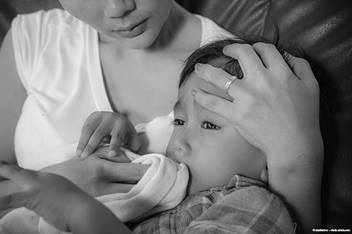Febrile Seizures

For most children, fevers cause minor discomfort, but in some, they can trigger seizures. If your child has a seizure when they have a fever, it’s called a febrile seizure. These are common types of seizures in children. They may be the first sign of illness because the seizure may happen before the child has a fever or other symptoms. Children with febrile seizures may not have a seizure each time they’re sick.
Many children get fevers when they’re sick. Medicines like acetaminophen (Children’s Tylenol®) or ibuprofen (Children’s Motrin® or Advil®) can help with fevers. These fever-reducing medicines may not prevent a seizure.
Febrile seizures:
- Are common between 6 months to 5 years old.
- May happen again if your child has already had one. It’s likely your child will have more than one febrile seizure if:
- Can be scary when you don’t know what they are. They usually don’t last long and don’t cause brain damage, learning disabilities, or epilepsy.
- Usually happen on the first day and in the first few hours of an illness with a fever.
- Can be associated with:
- A temperature of 100.4˚ Fahrenheit (F) or 38˚ Celsius (C) or higher.
- An infection like flu, chickenpox, or an ear infection.
- A recent vaccine that causes a fever. The fever, not the vaccine, makes it easier to have the seizure.
There are 2 types of febrile seizures:
| Simple (typical) | This is the most common type. A child has 1 seizure in 24 hours that affects their whole body and lasts less than 15 minutes. | |
| Complex (atypical) |
|
|
During a febrile seizure, a child may:
- Have irregular breathing.
- Clench the teeth or jaw.
- Pass out (lose consciousness).
- Flutter their eyelids or roll their eyes.
- Stiffen, jerk, or twitch their arm and leg muscles.
- Pee (urinate) or poop (bowel movement) in their pants.
What You Can Do
You can’t make the seizure stop. Do your best to stay calm and keep your child safe.
- If they’re sitting or standing, gently move them to the floor. Remove things nearby they may bump into, like a chair.

- Lay them on their side and turn their head to face downward (Picture 1).
- Loosen tight clothing. If your child wears glasses or hearing aids, remove them.
- Look to see exactly how your child moves and responds to you, so you can describe it later. If your phone is close, take a video of it.
- Write down how long the seizure lasts. If it’s less than 5 minutes, you don’t have to get emergency help. You can update your child’s doctor or health care provider for further direction. For seizures longer than 5 minutes, there may be medicine to give to stop the seizure.
What Not to Do
- Do not try to open your child’s mouth or place anything between their teeth. This could injure their gums, break their teeth, or make it easier to choke.
- Do not put your fingers into their mouth. They might bite them.
- Do not try to stop the movements.
- Do not use cold water or add rubbing alcohol to bath water to bring a fever down.
| Call 911 if your child: |
|
|
| Call your child's doctor or health care provider if they: |
|
|
After a Seizure
- When the seizure stops, your child may:
- Be tired and confused.
- Have a headache.
- Not remember having a seizure.
- Be a little cranky.
- Feel tired for a day or two.
- You don't have to change your lifestyle or the way you care for your child after a febrile seizure.
- Your child can safely sleep in their own crib or bed.
- If your child is acting sick and has other signs of illness, follow their doctor or health care provider's advice as your normally would.
- Typically, if your child has a febrile seizure, they don't need to go to a neurologist.
HH-I-195 • ©1998, revised 2023 • Nationwide Children's Hospital


